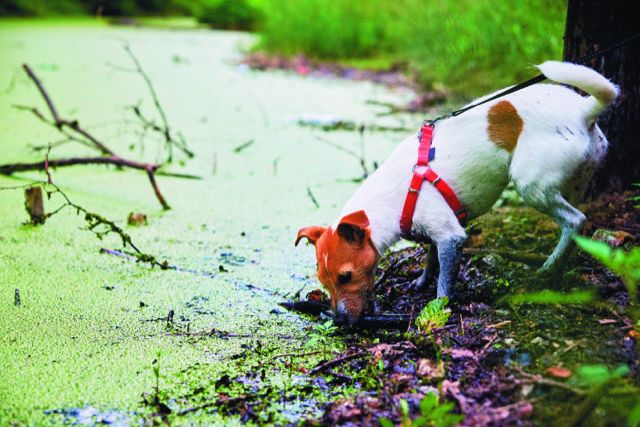From Texas to Oregon, North Carolina, Vermont, and many other states, dogs have died after swimming in water contaminated with blue-green algae, sometimes within hours of taking a dip. Blue-green algae is present in varying levels throughout the year, but algae blooms are most apt to flourish during the hotter months coming up or after a dry spell. You’ll find it in freshwater bodies of water that are stagnant — ponds, lakes, streams, and lazy rivers.
The blooms are actually deadly cyanobacteria that become visible to the naked eye once the bacteria clump together in high enough concentrations. They produce toxins that can cause everything from liver damage to a neurological assault, resulting in shock, respiratory failure, and yes, death. Other signs include vomiting, weakness, muscle tremors, and perhaps seizures or paralysis.
There is no treatment that directly targets the life-threatening toxins. All a veterinarian can do once a dog arrives at the hospital (often in critical condition) is offer supportive care: IV fluids, anti-seizure medications, electrolytes, and other therapies that might help stabilize a poisoned pet.
Better safe than sorry
Not all green-blue algae blooms are toxic, but there’s no way to know by looking. That’s why you have to keep your dog away from water that may contain it. Don’t let her walk or swim in any water that has visible algae blooms. Also, don’t let her near water that has scum or foam on the surface or even an odor. The blooms often have the appearance of a pea-green paint or will appear as if there’s slime on the surface, says the ASPCA. Sometimes, the organization says, the film concentrates along the shoreline.
In addition to keeping your dog away from potentially poisoned water, remove any stagnant water around your home that may have accumulated in cans or buckets, and frequently change the water in birdbaths, plant containers, and outdoor fountains.
If you think it’s possible that your dog has been exposed to an algae bloom, get her to a veterinarian’s office immediately. Don’t wait for signs.





